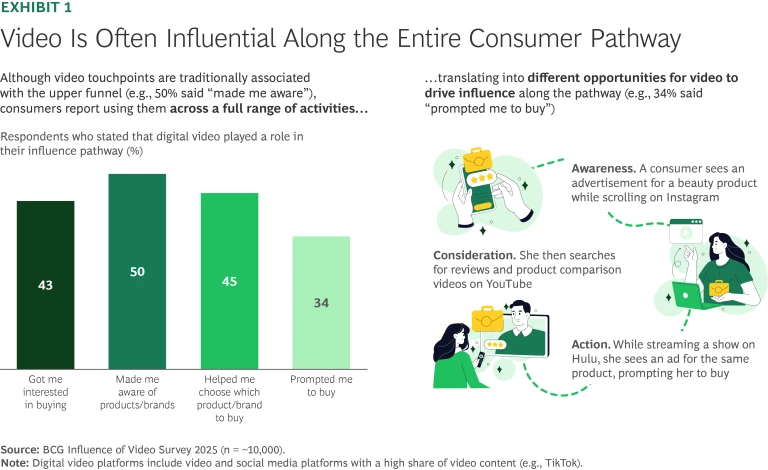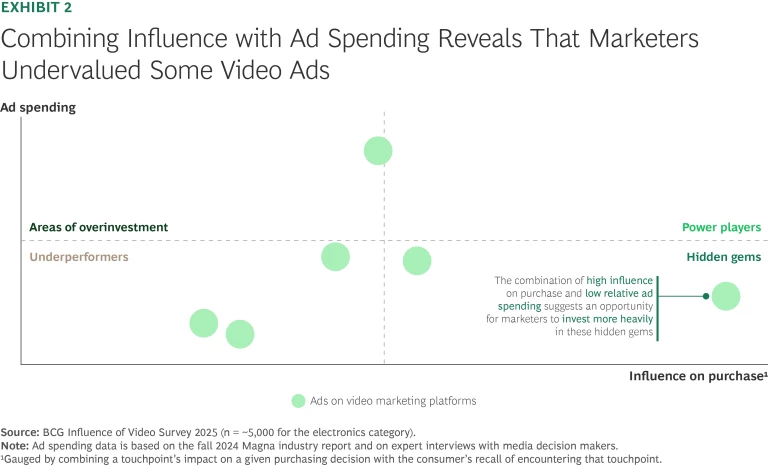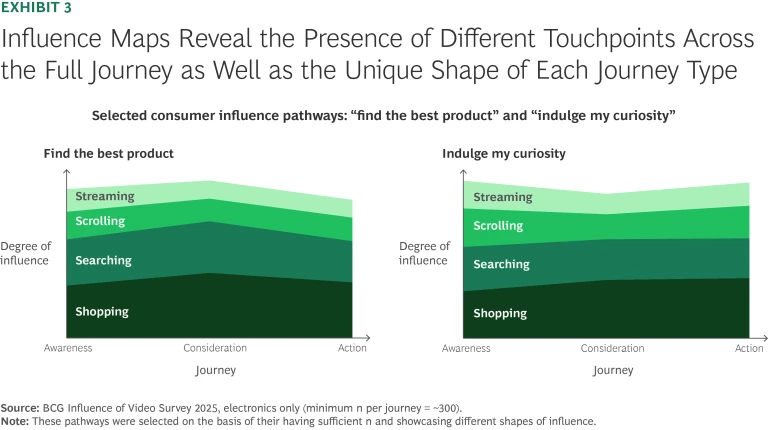How do consumer touchpoints—from websites and streaming videos to online searches and in-store visits—truly affect purchasing decisions? Marketers have traditionally looked to a linear marketing funnel for the answers, checking to see if a consumer became aware of a brand, considered a purchase, or made that purchase because of a given touchpoint along the funnel, and then assigning that touchpoint a key role in the funnel.
But consumers now engage with brands through a multitude of touchpoints, often repeatedly, in the course of journeys primarily defined by streaming, scrolling, searching, and shopping. And they become aware of products, consider them, and take action to buy them at multiple places along their purchasing pathway. Managing these consumer touchpoints has therefore become increasingly complex for marketers. Further complicating the work, the same touchpoints may play a different role and have a different level of influence along each unique pathway.
On the basis of extensive BCG research and experience, we proposed in a recent article that marketers shift their emphasis away from the rigid, sequential approach of the funnel to a touchpoint’s influence—its ability to meaningfully and memorably affect consumer demand and outcomes. In this follow-on discussion, we offer ways to understand the true impact of a touchpoint and pinpoint the most influential touchpoints on a given consumer pathway, enabling marketers to create influence maps for individual touchpoints that illuminate where the brand may be under- or overinvesting. The results: more effective and strategic marketing orchestration and media allocation, greater marketing ROI, and a systematic approach for discovering undervalued opportunities.
Which Touchpoints Truly Shape Consumer Decisions?
Consumers today may interact with a brand in myriad ways. They may hear about it through a creator on YouTube and then look for it on a site such as TikTok. They may later see a TV commercial that reminds them to do a Google search for the brand’s products, then listen to a creator on Instagram, get advice from a family member, do another online search, and finally be attracted by an in-store display or coupon before ultimately making a purchase.
As consumers jump from online to offline and back, some touchpoints can have tremendous influence, meaningfully affecting their choices and advancing them along the purchasing pathway. Without a full understanding of this dynamic, brands risk missing opportunities and spending less effectively, as some touchpoints go underfunded relative to their potential and others are oversaturated (and expensive). By analyzing the influence of a given touchpoint and the related marketing spending, in combination with their own strategic objectives, brands can uncover mismatches.
Video Drives Much More Than Awareness
Video offers a powerful example of the need to understand influence. From YouTube to social media to streaming services, consumers today spend unprecedented hours watching videos. These videos provide everything from brand discovery and product narrowing to in-depth reviews and social proof of a brand’s popularity. And they are ubiquitous, as consumers view them across devices and environments—while commuting, at home watching TV, or looking at content on their mobile phones. In multiple settings, video permeates their day.
Nevertheless, many marketers misconceive of video as sitting at the top of the funnel, primarily driving awareness.
To investigate this perception, we conducted a survey of approximately 10,000 beauty and electronics consumers, asking them about their recent interactions with specific touchpoints and their considerations and purchases of different brands. The video content included in our survey spanned organic or unpaid (whether brand- or creator-led), sponsored, and ad-based formats, with each format shaping consumer perceptions and decisions differently.
We used the resulting data to calculate the role that video and video platforms play on various consumer pathways. We also leveraged BCG’s Customer Influence Pathways (CIP), an offering within BCG’s proprietary End-to-End Demand Generation toolkit. CIP provides a comprehensive view of different shoppers’ motivations in different contexts and the priority touchpoints along their path to consideration and, ultimately, purchase.
In analyzing the results, we found that video has a much greater influence along the consumer journey—particularly along certain consumer pathways—than the traditional funnel model has led marketers to believe. Consumers in our survey were 2.5 times more likely to buy from brands they encountered through digital video interactions than from those they encountered on cable/broadcast tv. In addition, consumers who were heavily influenced by video reported that they were affected at multiple moments along the entire consumer purchase pathway. (See Exhibit 1.) Interestingly, we also found that creator-led video content—both organic and paid—generates the greatest trust and significantly shapes purchase decisions.

When we compared video’s influence with marketers’ related ad spending on video content, we found that, although its impact varied significantly with each consumer pathway, video tended to be underutilized as a marketing tool. Some digital video platforms had a large impact on brand consideration, some on final purchase, and some on both, depending on the consumer pathway. We measure influence by combining a touchpoint’s impact on a given purchasing decision with the consumer’s recall of encountering that touchpoint. (See Exhibit 2.)

How to Discover Mismatches in Spending
As in our video example, a touchpoint’s influence differs in shape and strength in each consumer pathway. Understanding the key pathways for a brand will therefore help simplify decision making for marketers over time, moving them from a complex, tangled view to a clearer, more prioritized one.
To support our research, we focused on five key pathways that we developed by analyzing shopping behaviors and motivations across the categories in our study, as follows:
- Find the best product. These shoppers look for larger, higher-stakes purchases and invest a great deal of time, energy, and money into researching different sources before buying.
- Indulge my curiosity. These consumers are driven by curiosity and external triggers, such as ads or influencers, and often visit a brand or retailer as well.
- Shop my ongoing interests. These shoppers browse regularly, stay updated, and indulge in their interests, keeping engaged and aware via rich content about what’s new in the given category.
- Match my vision and my means. The shoppers who take this pathway pursue a focused visual search, often on platforms or in marketplaces that prioritize visual content, balancing their style goals with their budgets.
- See if it works. These consumers begin with a loose plan, browse lightly, and narrow down their options over time, increasing their effort as they get closer to a purchase but remaining open to returning items that they don’t like after buying.
The pathways chosen would of course vary if we were working with different categories and brand contexts.
Marketers that understand their own brand’s key pathways can use that insight to create an influence map for the touchpoints along each pathway. (See Exhibit 3.) For example, one activity, such as scrolling, or a single platform, such as YouTube, may seal the deal for a given consumer, while for others they may play a supporting role—or none. As the exhibit illustrates, whether in planned (“find the best product”) or in spontaneous (“indulge my curiosity”) purchase journeys, marketers must understand the distinct influence patterns at work if they are to effectively orchestrate a marketing strategy and tailor communications and content to match consumer behaviors and maximize impact.

By grasping what the influence maps look like for a particular purchase pathway, marketers can optimize their marketing strategy—tailoring it to that pathway and identifying where they are over- or underinvested (with regard to both paid media and organic presence).
Understanding the Drivers of Influence
After identifying the touchpoints that truly sway consumer choices, marketers will naturally want to know why certain channels or content formats outperform others. One way to investigate this question is by looking at three behavioral factors—attention, relevance, and trust—that closely correlated with influence in the categories we studied:
- Attention. Some platforms spark quick awareness via short clips, while others support deeper product exploration.
- Relevance. Some types of content align more clearly with consumer needs than others do. Authentic creator content, brand-led demos, and third-party reviews all differ in perceived relevance.
- Trust. Consumers have more confidence in some platforms and content than in others. Factors such as authenticity, credible creators, and transparent sponsorships boost trust—and thus influence.
For example, one touchpoint might be a strong driver of choice, excelling in attracting consumer attention and gaining a great deal of trust. Another touchpoint might be high in relevance for meeting consumer needs yet fail to sustain enough attention for future recall. Recognizing how each touchpoint shapes consumer choice at specific steps along the pathway and pinpointing the factors that influence those choices at those moments can help marketers orchestrate the right channel mix, messaging, content format, and even partnerships to maximize their marketing ROI.
In addition, marketers should connect the content itself to a differentiated value proposition grounded in consumer needs and in the drivers of consumer choice. Businesses can use BCG's Demand Centric Growth (a differentiated approach to understanding what drives consumer choice in different contexts) in conjunction with their influence maps to provide the right framework for generating winning content.
Taking Practical Steps
Marketers can develop influence maps by researching their consumers’ motivations and then using these maps to understand their priority actions. We recommend taking the following steps:
- Identify distinct consumer purchase pathways for their market, and determine which pathways involve situations where the brand is differentiated and where marketers believe they have the “right to win.”
- For these priority pathways, find the channels and content types that have the greatest influence and truly affect the desired behavior.
- Using this information, identify where the brand may be over- or underinvesting, and alter that balance to drive growth.
- Set up a pilot to test the impact of this tailored orchestration across platforms, products, messaging, and creatives, based on selected pathways.
- Measure the impact of these tailored activities on brand equity through brand lift or via BCG’s First-Fast Response metric, using that data to create the optimal media mix and marketing activities.














